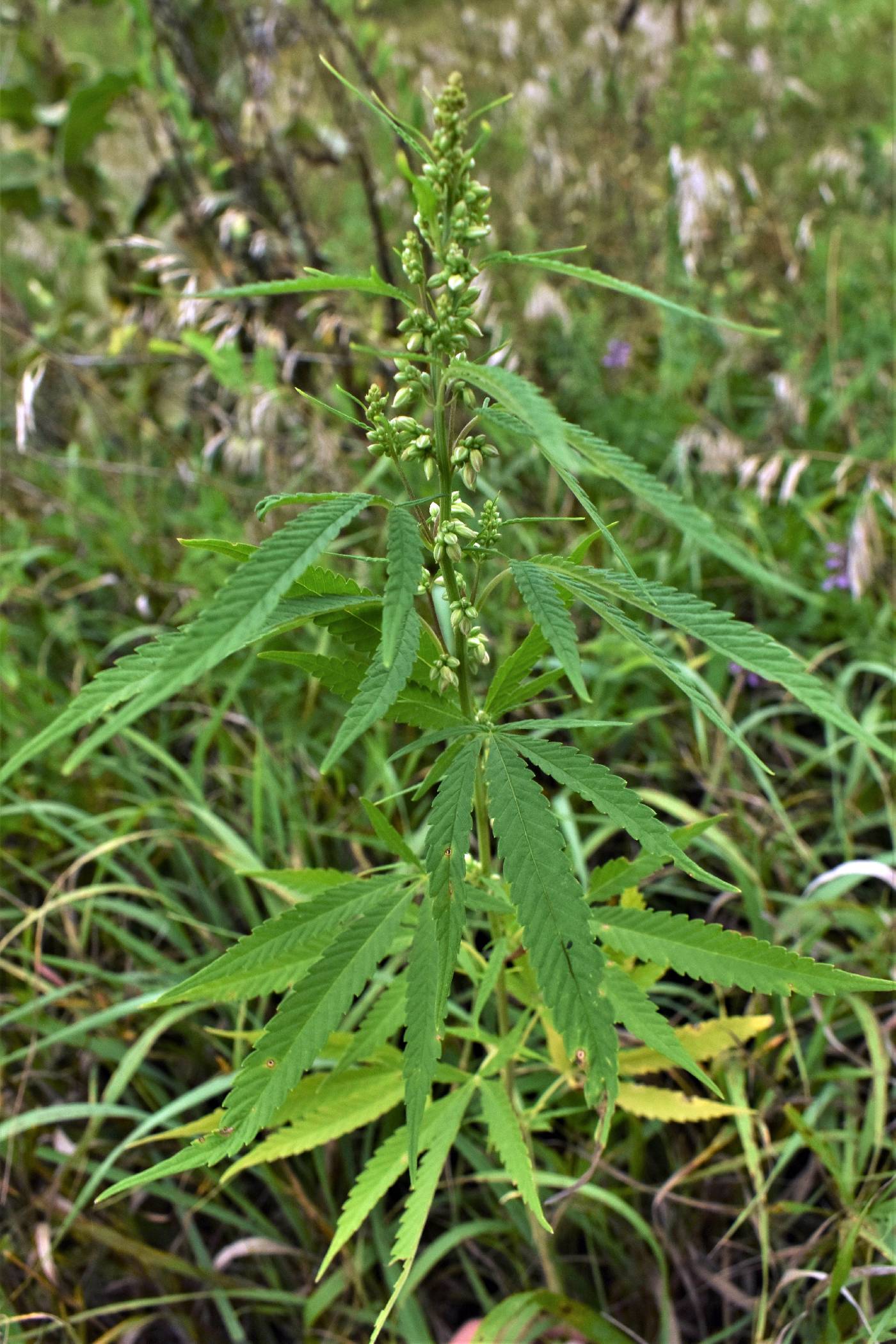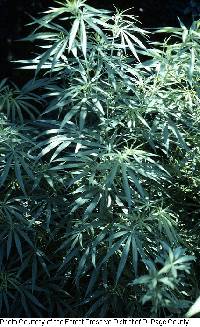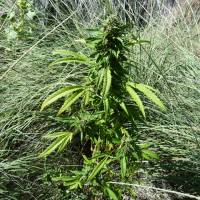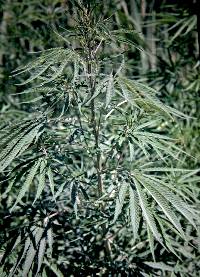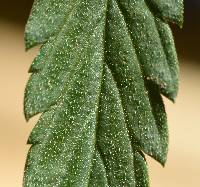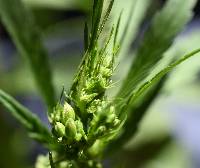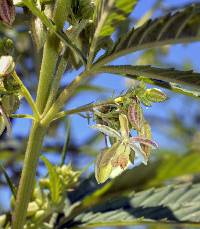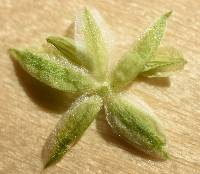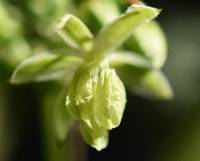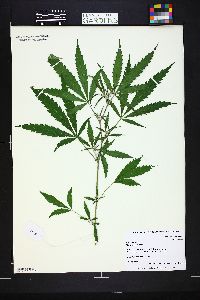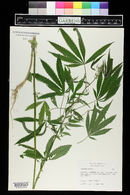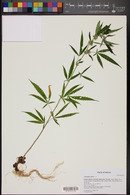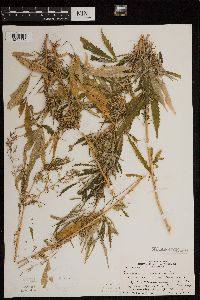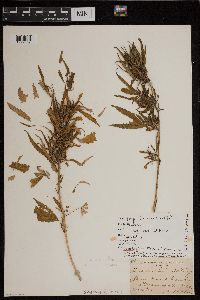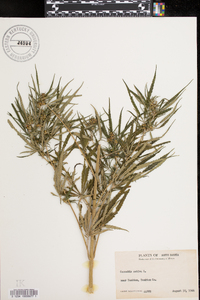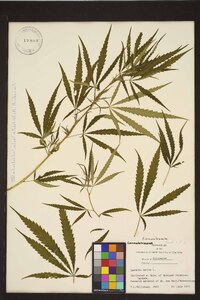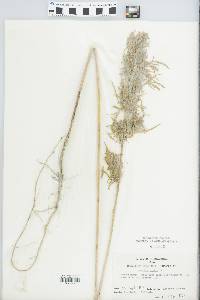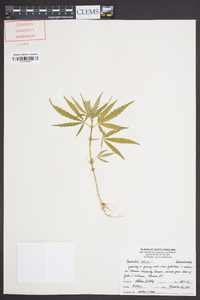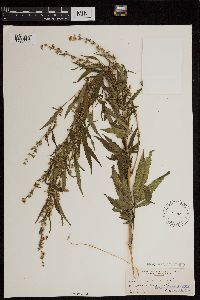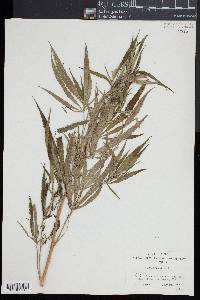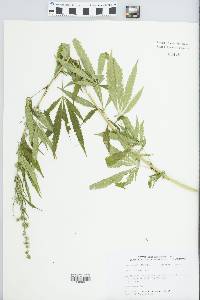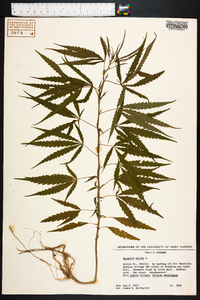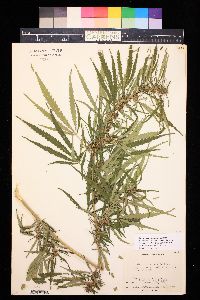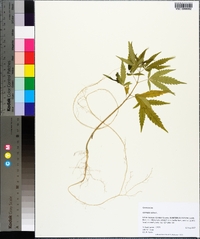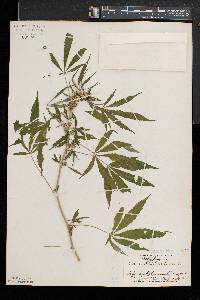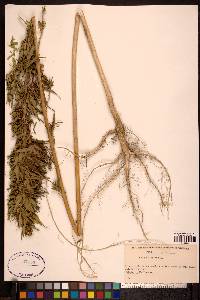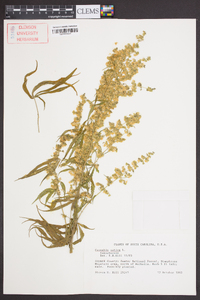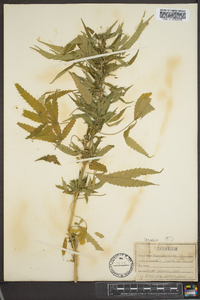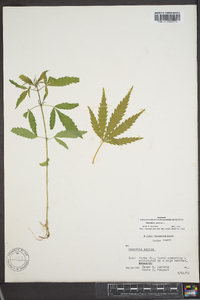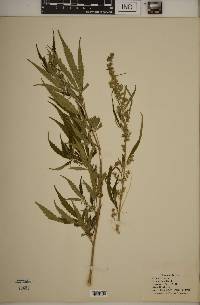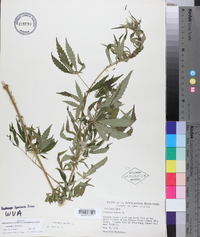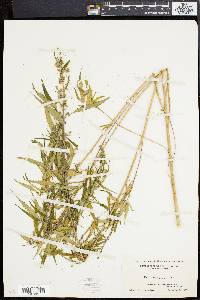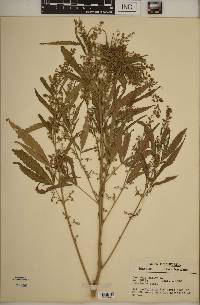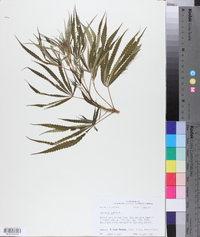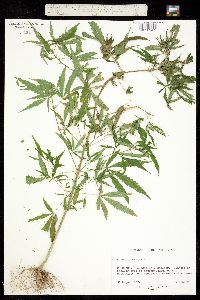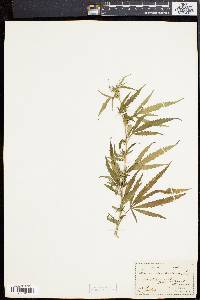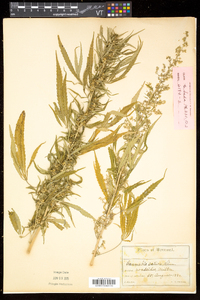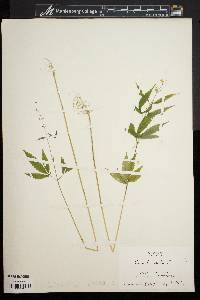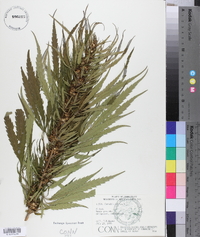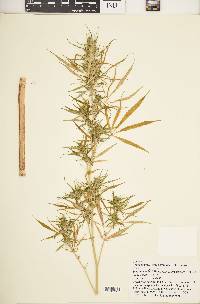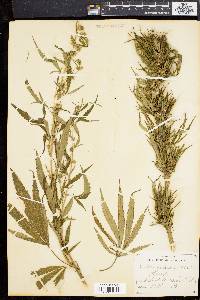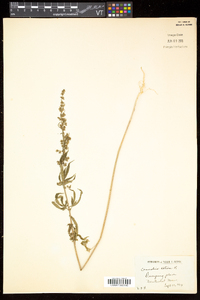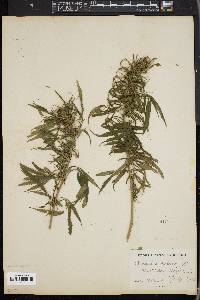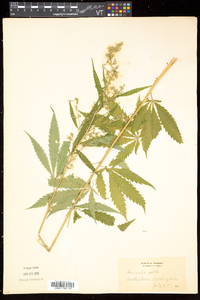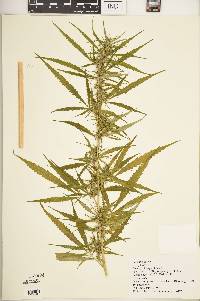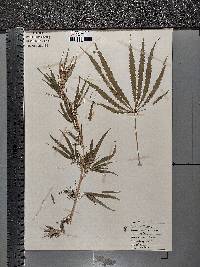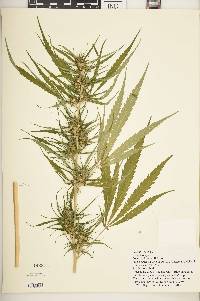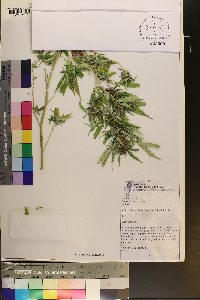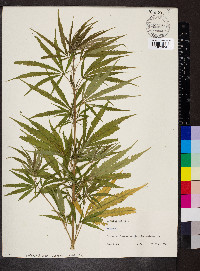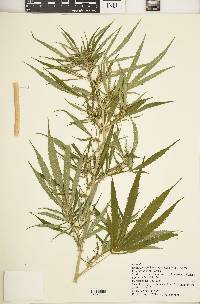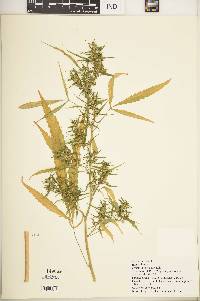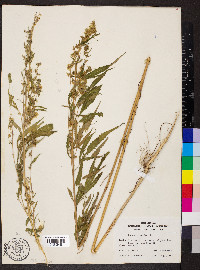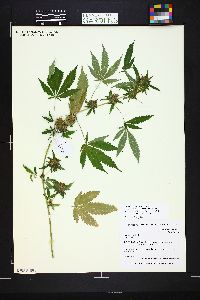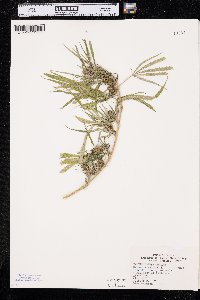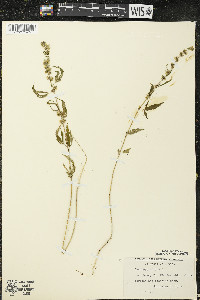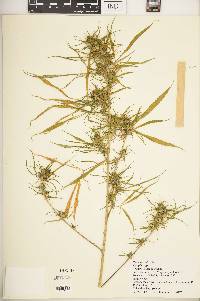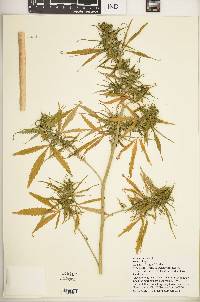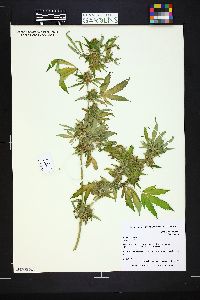Cannabis sativa
|
|
|
|
Family: Cannabaceae
Hemp, more...grass, hashish, marijuana, Mary Jane, pot (es: mota, mariguana)
[Cannabis ruderalis, moreCannabis sativa var. indica , Cannabis sativa var. spontanea] |
Staminate plants usually taller, less robust than pistillate plants. Stems 0.2-6 m. Leaves: petioles 2-7 cm. Leaflet blades mostly 3-9, linear to linear-lanceolate, 3-15 × 0.2-1.7 cm, margins coarsely serrate; surfaces abaxially whitish green with scattered, yellowish brown, resinous dots, strigose, adaxially darker green with large, stiff, bulbous-based conic hairs. Inflorescences numerous. Flowers unisexual, often transitional flowers and flowers of opposite sex developing later. Staminate flowers: pedicels 0.5-3 mm; sepals ovate to lanceolate, 2.5-4 mm, puberulent; stamens caducous after anthesis, somewhat shorter than sepals; filaments 0.5-1 mm. Pistillate flowers ± sessile, enclosed by glandular, beaked bracteole and subtended by bract; perianth appressed to and surrounding base of ovary. Achenes white or greenish, mottled with purple, ovoid, somewhat compressed, 2-5 mm, with ± persistent perianth that sometimes flakes off. 2 n = 20. Flowering early summer-fall; staminate plants generally dying after anthesis, pistillate plants remaining dark green, persisting until frost. Well-manured, moist farmyards, and in open habitats, waste places (roadsides, railways, vacant lots), occasionally in fallow fields and open woods; 0-2000 m; introduced; principal naturalized range (see map) Ont., Que.; Ark., Conn., Del., Ill., Ind., Iowa, Kans., Ky., Maine, Md., Mass., Mich., Minn., Mo., Nebr., N.H., N.J., N.Y., N.Dak., Ohio, Okla., Pa., R.I., S.Dak., Vt., Va., W.Va., Wis.; native to Asia. Cannabis sativa has been reported as cultivated illegally and as apparently ruderal in all provinces and states except Alaska. It has been collected least frequently in Mississippi and Idaho. It seems to be best established in the prairies and plains of central North America. Hemp is a short-day plant; flowering depends upon the latitude of origin. Races originating closer to the equator (and generally higher in psychointoxicant) require a longer induction period for flowering than races originating farther north. The taxonomy of Cannabis sativa , a polymorphic species, has been debated in scientific and legal forums. The name C . sativa subsp. indica (Lamarck) E. Small & Cronquist has been applied to plants with a mean leaf content of the psychotomimetic (hallucinatory) delta-9-tetrahydrocannabinol of at least 0.3%; those with a lesser content fall under C . sativa subsp. sativa . When separate species are recognized, the name C . indica Lamarck has generally been applied to variants with high levels of the intoxicant chemical, whereas the name C . sativa Linnaeus, interpreted in a restricted sense, has generally been applied to plants selected for their yield of bast fibers in the stems. (The latter generally have taller, hollow stems with longer internodes and less branching than races selected for drug content.) Superimposed on this dimension of variation is selection for nonabscising achenes in cultivation and abscising achenes in the wild (i.e., outside of cultivation). This is analagous to selection of nonshattering cereals from wild, shattering grasses. Achenes selected for cultivation tend to be longer than 3.8 mm and lack a basal constricted zone; by contrast, achenes selected for wild existence tend to be shorter than 3.8 mm and to have a basal constricted zone that seems to facilitate disarticulation and a mottled, persistent perianth apparently serving as camouflage. Within Cannabis sativa subsp. sativa , the wild phase has been named C . sativa var. spontanea Vavilov (= C . ruderalis Janishevsky), in contrast to the domesticated C . sativa var. sativa . Within C . sativa subsp. indica , the wild phase (not to be expected in North America) has been designated C . sativa var. kafiristanica (Vavilov) E. Small & Cronquist, as distinct from the domesticated C . sativa var. indica . The chemical and morphologic distinctions by which Cannabis has been split into taxa are often not readily discernible, appear to be environmentally modifiable, and vary in a continuous fashion. For most purposes it will suffice to apply the name Cannabis sativa to all plants encountered in North America. * The Iroquois used Cannabis sativa medicinally to convince patients that they had recovered. They also found it useful as a stimu Plant: Annual dioecious erect herb; to 6 m tall, without forked hairs Leaves: palmately compound with 3-9 linear to linear-lanceolate leaflets, 3-15 cm long, 0.2-1.7 cm wide, the margins serrate INFLORESCENCE: numerous; staminate inflorescences cymes or panicles, pistillate inflorescences erect or spreading congested spikes Flowers: staminate flowers on pedicels 0.5-3 mm long, the sepals ovate to lanceolate, 2.5-4 mm long; pistillate flowers subsessile, enclosed in a bracteole and subtended by a bract Fruit: white, mottled with purple, lenticular, enclosed by the enlarged persistent calyx Misc: 700-1150 m (2300-3700 ft); Feb-Sep REFERENCES: Mason, Charles T., Jr. 1999. Cannabaceae. Ariz. - Nev. Acad. Sci. 32(1). Annual herb 20 cm - 6 m tall Stem: upright. Leaves: mostly opposite (upper ones commonly alternate), palmately compound with three to nine leaflets (upper ones with fewer or no leaflets), stalked. Leaf stalks 2 - 7 cm long. Leaflets whitish green with yellowish brown resinous dots beneath, darker green above, 3 - 15 cm long, 2 mm - 1.7 cm wide, linear to narrowly lance-shaped, coarsely saw-toothed, appressed-hairy beneath, with large, stiff hairs above. Flowers: either male or female, borne on separate plants (dioecious), greenish, small, without petals. In some cases, as with many cultivars, the male and female flowers are on the same plant. Male flowers short-stalked, with 2.5 - 4 mm long, egg- to lance-shaped, minutely hairy sepals. Female flowers more or less stalkless, enclosed by a glandular bractlet, and subtended by a bract. Fruit: a lens-shaped achene, enclosed inside the enlarged perianth (the sepals and petals, collectively), white to greenish, mottled with purple, 2 - 5 mm long, egg-shaped, somewhat compressed, subtended by a bract. Male inflorescence: an upright, loose, compound cluster of flowers. Female inflorescence: a small, axillary cluster of flowers on a short, leafy branch. Similar species: See the Notes section and also the links to the other Cannabis species. Flowering: August Habitat and ecology: Introduced from Eurasia. Grows as a weed in waste ground, along fences, and in pastures. Many wild plants in the Chicago Region are from a strain originally cultivated for hemp fiber. Occurence in the Chicago region: non-native Notes: Many populations are the result of escapes from regular and clandestine cultivation. It has been cultivated for a long time, and its tough, durable fiber was used to make rope, paper, and a multitude of other useful products. This, in turn, caused it to spread around the world. For more information on the taxonomy of this plant see Cannabis sativa at the following link. Etymology: Cannabis comes from the Greek word kannabis, meaning hemp. Sativa means cultivated. Author: The Morton Arboretum Stem 1-3 m; lfls lance-linear to lance-elliptic, pubescent, 5-15 cm, toothed; achene in ours mostly 3.8-4.5 mm. Native of Eurasia, cult. in many parts of the world, and found here and there in our range. Late summer. Complex sp., differentiated under the influence of cult. into a northern subsp. sativa, used for production of fiber (hemp) from the bast, and a southern subsp. indica (Lam.) E. Small & Cronquist, harvested for an intoxicating, hallucinogenic drug in the epidermal resin glands. The crude flowering or fruiting material is marijuana; the extracted resin is hashish. Plants growing wild in our range are all or nearly all descended from plants formerly cult. for fiber, and the resin has a relatively small percentage of intoxicant. They may be referred to subsp. sativa var. sativa. Our plants appear to be in process of reversion toward the wild-adapted var. spontanea Vavilov (C. ruderalis), marked by its relatively small size, and more especially by its smaller (less than 3.8 mm), irregularly blotched achenes with a variable period of dormancy. Parallel vars. adapted to growth in cult. or in the wild exist in subsp. indica. Gleason, Henry A. & Cronquist, Arthur J. 1991. Manual of vascular plants of northeastern United States and adjacent Canada. lxxv + 910 pp. ©The New York Botanical Garden. All rights reserved. Used by permission. From Flora of Indiana (1940) by Charles C. Deam This species yields a strong fibre which is extensively used for cordage. It was formerly sown in northern Indiana for its fibre. The seed of this plant are much used in commercial bird foods, and this accounts for its escape in all parts of the state. The plant grows 6-10 feet high and produces an abundance of seed; it might well be grown for winter food for birds, and people who provide feed for birds during the winter months should be interested in sowing enough hemp to produce a few sheaves of it to be used for this purpose. Hemp is also the source of the narcotic hashish or marihuana, and growing it in Indiana is now prohibited. This species prefers a moist, rich soil but I have found it in almost all kinds of soils and locations. It is usually found in waste places, along roadsides, streams and railroads, and infrequently in fallow fields and open woods. In the Kankakee region it is frequent in low ground along fences and on ditch banks. ...... Indiana Coefficient of Conservatism: C = null, non-native Wetland Indicator Status: n/a |
|
|
|

